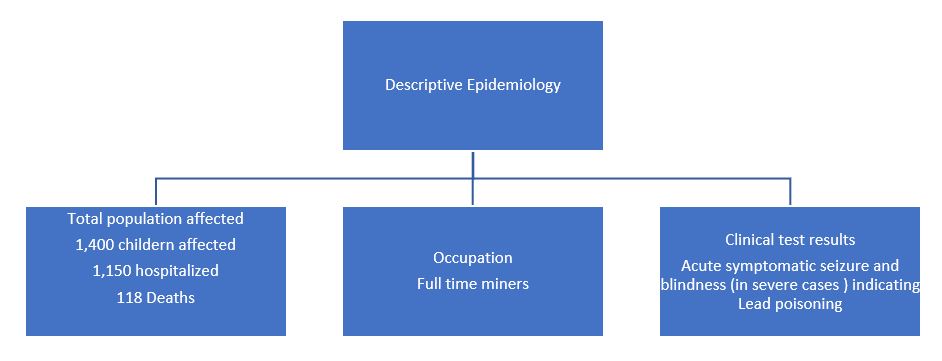Introduction
An outbreak has erupted in Zamfara province in the northwestern section of Nigeria. Doctors confirmed that three villages within Zamfara province are at the heart of the crisis (CDC, n.d). The deadly outbreak known as lead poisoning has claimed 118 children below the age of five. The number of sick children has grown to 1,400, with 1,150 victims hospitalized. A first stop outside the villages depicts a horrific scene of 100 small newly dug graveyards (CDC, n.d). The situation is alarming because the outbreak came from the mining activities done within the area. The challenge is that the natives cannot stop this business because it is their only source of income. The most exposed population are children because they play on the ground where the contaminants are more concentrated (Kurup et al., 2019). Their parents also return from work soaked in dust that is confirmed to be toxic which increases poisoning. This paper explores some of the epidemiological processes applied in the identification process of lead poisoning (Kurup et al., 2019).
Solve the Outbreak Challenge
“The Village of Gold” is a Center for Disease Control and Prevention game that requires an individual to answer specific entries to define an outbreak (CDC, n.d). After answering the prompts in the game, I discovered the outbreak affecting the people of Zamfara Province (CDC, n.d). Lead poisoning was an outbreak that emerged from the mining activities performed in the area, and this contributed to the poisoning and death of children in the region. The causes, effects, and impact of mineral extractions are revealed through the use of epidemiological processes.
The Epidemiological Processes Applied
Epidemiology is an unbiased process of collection, evaluation, and interpretation of data within a specific population. The principles of epidemiology seek to define the frequency and the pattern of a health situation in a specified area (CDC, n.d). In this scenario of lead poisoning in the Zamfara province, I applied some of the epidemiological checklists approved by the Field Epidemiology Training Program (FETP), which helps extract data on the overall characteristics of an outbreak report and the steps applied (Kurup et al., 2019). The FETP approach used to identify and assess the outbreak included the following steps.
- Confirmation of the outbreak.
- Verification of the diagnosis.
- Case definition.
- Case finding.
- Descriptive epidemiology.
- Hypothesis.
- Analytical epidemiology.
Confirmation
The sudden surge in the mortality rate and the number of hospitalized children indicated an epidemic. I used the confirmation technique to analyze data gathered from Zamfara province and concluded that there was a rising curve in the number of affected (CDC, n.d.) Initially, the number of infections was at 150, which increased to a total of 1,400 affected children with more than 1000 hospitalized (CDC, n.d). The rising number of the affected automatically indicated an outbreak.
Verification of Diagnosis
Some of the children admitted to the hospital showed symptoms characterized by abdominal pain, headache, vomiting, and convulsions (CDC, n.d). Doctors had tried administering anti-malaria and antibiotic drugs, and none have worked since the first administration. A laboratory test had to be conducted to confirm the outbreak because it could not be physically examined. Laboratory results reveal that the patients (Majorly children) have a high level of lead in their blood, confirming that they have been exposed to lead poisoning (CDC, n.d).
Case Definition
After the test results, it was evident that the patients were suffering from Lead poisoning, something they acquired from the mining site where they spend most of their time (CDC, n.d). Some reported having extended their mining activities to their homes to make ends meet. The incubation period was unknown, and all the residents were at risk.
Descriptive Epidemiology
This technique helped me to analyze the information about the persons associated with the outbreak (Kurup et al., 2019).

Hypothesis
The primary cause of lead poisoning is exposure to lead-contaminated soil and air. During the extraction of minerals, exposure to lead-contaminated dust and soil is inevitable (Kurup et al., 2019). Children play with the soil, and this interaction increases their risk of being poisoned (CDC, n.d). Also, the natives do not use any protective clothing during mining, which means that they breathe in a lot of contaminated dust. If the natives take extra caution during mining by wearing protective gear and residing in far areas away from the site, the poisoning could decline.
Analytical epidemiology
At this stage, I applied the case-control study, which compares the exposure among cases and controls (Kurup et al., 2019). In this analysis, I realized that the poverty rate in Zamfara province was a contributing factor to poisoning. The people had no alternative income-generating activity, and this meant that they had to mine. Also, they could not afford to buy protective clothing that secured them from lead exposure.
Conclusion
The epidemiological processes of disease identification have played an essential role in explaining the outbreak investigation. For the Zamfara case scenario, the epidemiological techniques have enabled me to describe the outbreak report by focusing on specific characteristics such as the population affected, the prevalence of infection, zoned area, and the type of outbreak. The descriptive and analytic epidemiology have supported the explanation of the occurrence of the outbreak by providing a comprehensive framework that helped assess the exposures and risks associated with this lead poisoning.
References
Center for Disease Control and Prevention. (n.d). Solve the outbreak; the village of gold. Web.
Kurup, K. K., John, D., Ponnaiah, M., & George, T. (2019). Use of systematic epidemiological methods in outbreak investigations from India, 2008–2016: A systematic review. Clinical Epidemiology and Global Health, 7(4), 648-653. Web.